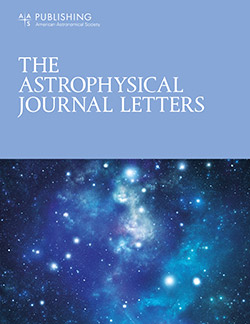Quasiperiodic Peak Energy Oscillations in X-Ray Bursts from SGR J1935+2154
IF 8.8
1区 物理与天体物理
Q1 ASTRONOMY & ASTROPHYSICS
引用次数: 0
Abstract
Abstract Magnetars are young neutron stars powered by the strongest magnetic fields in the Universe (10 13–15 G). Their transient X-ray emission usually manifests as short (a few hundred milliseconds), bright, energetic (∼10 40–41 erg) X-ray bursts. Since its discovery in 2014, SGR J1935+2154 has become one of the most prolific magnetars, exhibiting very active bursting episodes and other fascinating events, such as pulse timing antiglitches and fast radio bursts. Here we present evidence for possible 42 Hz (24 ms) quasiperiodic oscillations in the ν F ν spectrum peak energy ( E p ) identified in a unique burst detected with the Fermi Gamma-ray Burst Monitor in 2022 January. While quasiperiodic oscillations have been previously reported in the intensity of magnetar burst light curves, quasiperiodic oscillations in E p have not. We also find an additional event from the same outburst that appears to exhibit a similar character in E p , albeit of lower statistical quality. For these two exceptional transients, such E p oscillations can be explained by magnetospheric density and pressure perturbations. For burst-emitting plasma consisting purely of e + e − pairs, these acoustic modes propagate along a highly magnetized flux tube of length up to around L ∼ 130 neutron star radii, with L being lower if ions are present in the emission zone. Detailed time-resolved analyses of other magnetar bursts are encouraged to evaluate the rarity of these events and their underlying mechanisms.SGR J1935+2154 x射线爆发的准周期峰值能量振荡
磁星是由宇宙中最强磁场(10 13-15 G)驱动的年轻中子星。它们的瞬态x射线发射通常表现为短暂(几百毫秒)、明亮、高能(10 40-41尔格)的x射线爆发。自2014年发现以来,SGR J1935+2154已经成为最多产的磁星之一,表现出非常活跃的爆发事件和其他迷人的事件,如脉冲定时反故障和快速射电暴。在这里,我们提供了可能的42赫兹(24毫秒)准周期振荡的证据,在2022年1月由费米伽马射线暴监测器探测到的一个独特的爆发中发现了ν F ν谱峰值能量(E p)。虽然以前在磁星爆发光曲线的强度中已经报道过准周期振荡,但在E p中还没有报道过准周期振荡。我们还发现了来自同一爆发的另一个事件,该事件似乎在E p中表现出类似的特征,尽管统计质量较低。对于这两个异常瞬态,这样的电磁振荡可以用磁层密度和压力扰动来解释。对于纯粹由e + e−对组成的爆发发射等离子体,这些声模式沿着高度磁化的通量管传播,长度可达L ~ 130中子星半径,如果在发射区存在离子,则L较低。鼓励对其他磁星爆发进行详细的时间分辨分析,以评估这些事件的罕见性及其潜在机制。
本文章由计算机程序翻译,如有差异,请以英文原文为准。
求助全文
约1分钟内获得全文
求助全文
来源期刊

Astrophysical Journal Letters
ASTRONOMY & ASTROPHYSICS-
CiteScore
14.10
自引率
6.30%
发文量
513
审稿时长
2-3 weeks
期刊介绍:
The Astrophysical Journal Letters (ApJL) is widely regarded as the foremost journal for swiftly disseminating groundbreaking astronomical research. It focuses on concise reports that highlight pivotal advancements in the field of astrophysics. By prioritizing timeliness and the generation of immediate interest among researchers, ApJL showcases articles featuring novel discoveries and critical findings that have a profound effect on the scientific community. Moreover, ApJL ensures that published articles are comprehensive in their scope, presenting context that can be readily comprehensible to scientists who may not possess expertise in the specific disciplines covered.
 求助内容:
求助内容: 应助结果提醒方式:
应助结果提醒方式:


